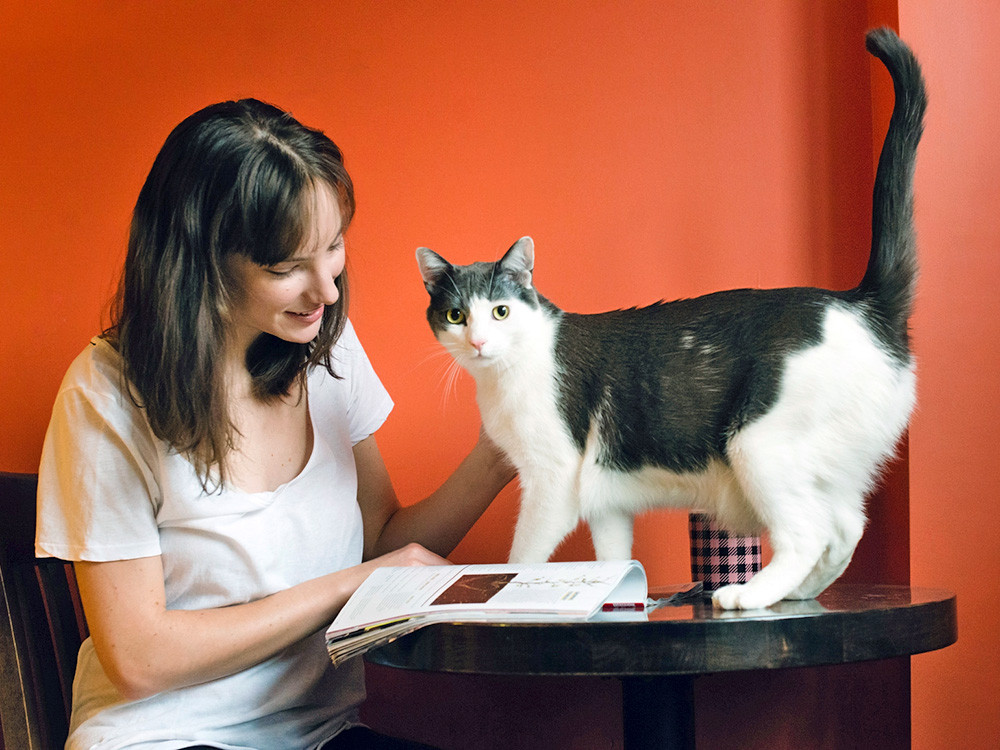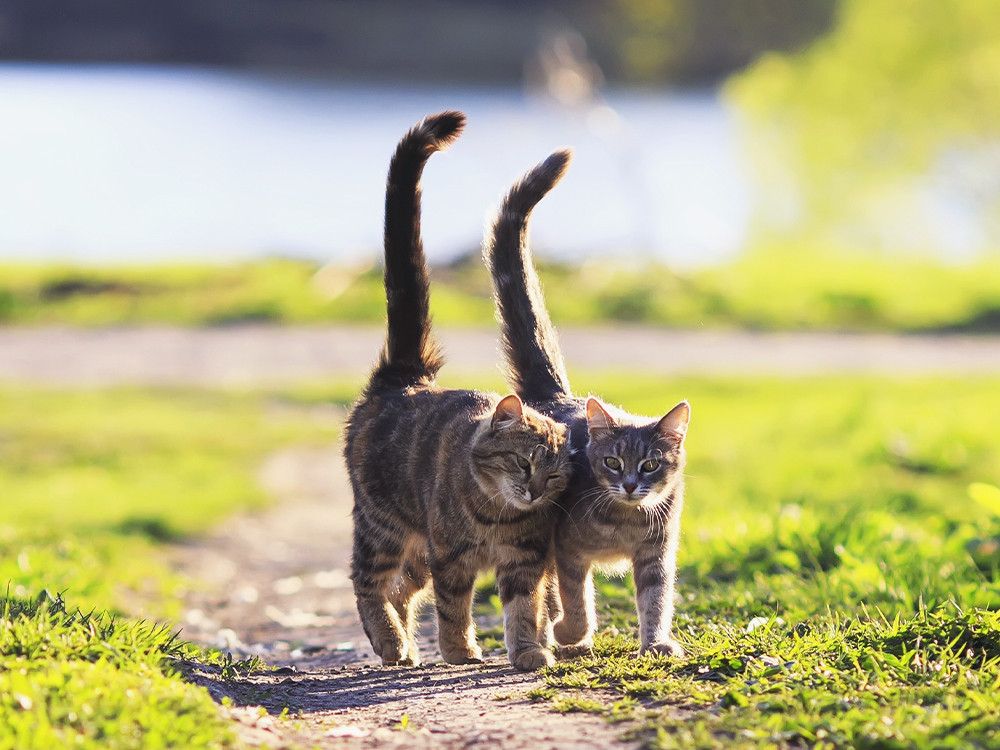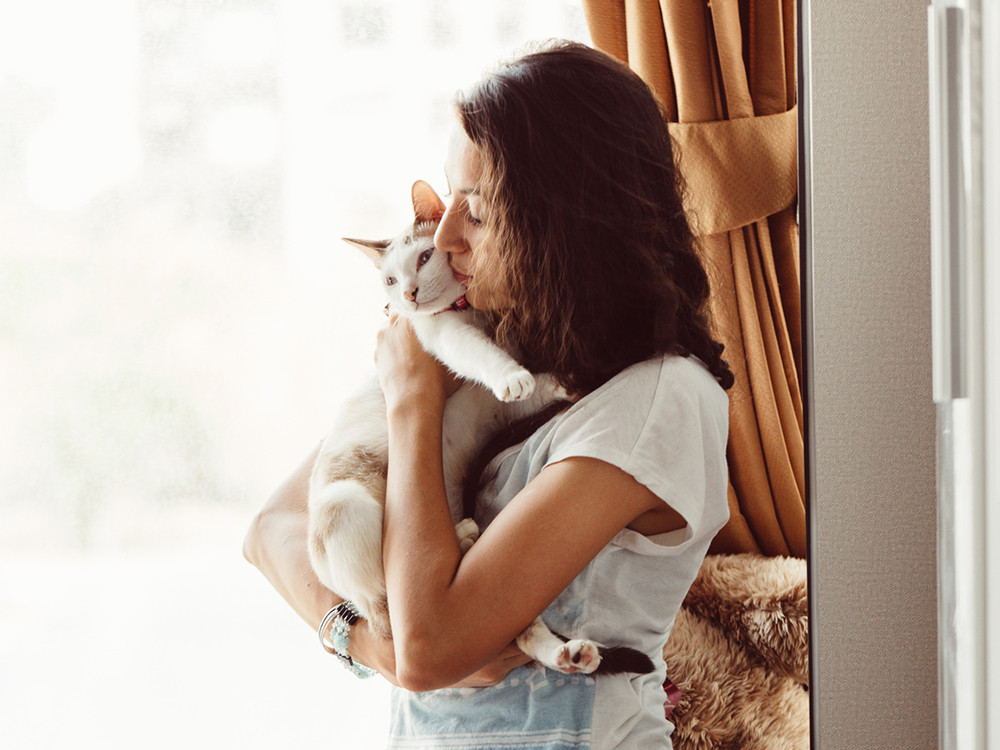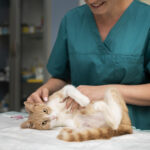They’re trying to tell you something… and it might be more exciting than you think!
By Marci Koski, CFTBP, FFCP
 Woman gently petting a tabby cat on a desk, showcasing a moment of calm interaction between a cat and its owner.
Woman gently petting a tabby cat on a desk, showcasing a moment of calm interaction between a cat and its owner.
Have you ever noticed your feline friend standing tall, tail held high and quivering like a hummingbird’s wings? This fascinating behavior, known as cat tail vibration, is a common sight for cat owners. But what exactly does it mean when your cat’s tail vibrates? Often observed when cats greet you, express excitement, or even mark their territory, this tail movement is a key element of feline communication. It’s a natural, involuntary response controlled by their nervous system, typically signaling a state of heightened interest or anticipation. To truly understand your cat, learning to interpret their tail language, especially the meaning behind a vibrating tail, is essential. Let’s delve deeper into the world of feline tail talk and uncover the secrets behind those tail vibrations.
Cat Tails and Body Language: A Visual Guide to Feline Emotions
Understanding your cat goes beyond just meows and purrs. Cats are masters of subtle communication, and their body language, particularly their tail, speaks volumes. A cat’s tail is a dynamic indicator of their emotional state, acting as a visual semaphore that broadcasts their feelings to both humans and other animals. From the twitch of an ear to the slow blink of an eye, feline body language is a complex system, with the tail playing a starring role. Tail positions and movements are some of the most obvious and easily observable signals cats use to communicate. This “tail-speak” is crucial for social interactions, helping cats navigate their world and express a range of emotions without uttering a single meow. For us humans, learning to read these tail signals is key to understanding our feline companions better and strengthening our bond with them.
The Importance of Context
Just like human communication, context is everything when interpreting cat body language. A tail wag can mean different things in different situations. Is your cat in a familiar, comfortable environment, or are they in a new place feeling anxious? Are they interacting with a friendly, known cat, or facing a stranger? A cat’s mood – whether they are playful, hungry, relaxed, or stressed – will significantly influence their body language. Therefore, observing the entire situation, not just the tail, is vital for accurate interpretation. Consider the surroundings, any other animals present, and your cat’s recent activities to get a complete picture of what they are trying to communicate. A single tail movement can have multiple meanings, and only by considering the context can you accurately decipher your cat’s message.
Decoding Tail Positions and Movements
Cats use a rich vocabulary of tail positions and movements to express themselves. Generally, a higher tail indicates a more positive emotion, like confidence or friendliness. A tail held straight up, or even with a slight curve at the tip, is a sign of a happy and social cat, often an enthusiastic greeting. Conversely, a tail tucked low or wrapped around the body suggests insecurity, anxiety, or fear. A thumping or rapidly twitching tail usually signals irritation or agitation, a clear warning to approach with caution. And the classic “puffed-up” tail, where the fur stands on end, is a definitive sign of fear or aggression, indicating it’s best to give the cat space. Understanding these basic tail postures is your first step in becoming fluent in feline body language.
 Two cats walking outdoors with their tails held straight up, indicating a confident and friendly demeanor.
Two cats walking outdoors with their tails held straight up, indicating a confident and friendly demeanor.
Unpacking the Vibrating Cat Tail: Reasons Behind the Quiver
The vibrating cat tail, sometimes referred to as a shaking or quivering tail, is a particularly interesting and often endearing feline behavior. It typically occurs in specific situations: when you’re petting your cat, when they spot you across the room, or even in anticipation of a meal. While there might be several underlying reasons for this shaky tail, excitement and anticipation are generally considered the primary drivers. Let’s explore the common reasons why your cat might be vibrating their tail:
Pure Happiness and Excitement
If you share a close, loving bond with your cat, you’re likely familiar with the happy tail vibration. This often happens when your cat approaches you, greets you after a short absence, or interacts with other friendly cats in the household. Consider a vibrating tail a high compliment from your feline companion. It’s a clear sign of affection and positive feelings towards you. This joyful quiver is a wonderful affirmation of your relationship with your cat, indicating they are truly happy in your presence.
Urine Spraying and “Phantom Spraying”
Tail vibration is intrinsically linked to urine-spraying behavior in cats. When a cat sprays urine to mark their territory, they will usually back up to a vertical surface, raise their tail high, and release a stream of urine. During this process, their tail will often vibrate or quiver noticeably. Interestingly, cats also engage in “phantom spraying,” where they exhibit the same spraying posture and tail vibration without actually releasing any urine. This phantom behavior, sometimes humorously called “tinkle tail,” is believed to be triggered by the same motivations as regular spraying, such as territorial marking or anxiety. While phantom spraying itself isn’t a cause for immediate concern, it can signal underlying stress or territorial insecurity.
Anxiety and Nervous Energy
While often associated with positive emotions, a vibrating tail can also be a sign of anxiety or nervousness in cats. As mentioned earlier, phantom spraying, accompanied by tail vibration, can be triggered by anxiety or territorial concerns. Furthermore, general anxiety can manifest as increased tail movement, such as a constant back-and-forth swishing, even when there are no obvious external stimuli. If you suspect anxiety is the reason behind your cat’s tail vibrations, it’s crucial to address the potential stressors in their environment. Engaging your cat in interactive play with a wand toy can be a great way to help them release pent-up nervous energy in a healthy and productive manner.
Impatience and Anticipation
Cats are creatures of habit and can be quite impatient when their routines are disrupted or when they are anticipating something they desire. Think of it like a person tapping their foot while waiting impatiently. A cat might express similar impatience by vibrating or twitching their tail, especially when waiting for food, playtime, or attention. This type of tail movement might be less of a full-body vibration and more of a partial twitch or swish, signaling “Hurry up!” It’s their way of reminding you, none too subtly, to fulfill their needs and desires promptly.
Anger and Irritation
While less commonly a “vibration,” tail movements associated with anger or irritation can sometimes be confused with tail quivering. However, an angry cat’s tail is more likely to exhibit rapid swishing from side to side or forceful thumping against the ground. The more vigorous the tail movement, the greater the cat’s agitation. These tail signals are clear warnings to give the cat space and avoid interaction. If you recognize these signs of anger, try to identify and remove the source of their distress to de-escalate the situation. Creating a positive and comfortable environment will increase the chances of seeing those happy tail vibrations instead!
In most cases, a vibrating cat tail is a positive sign, indicating excitement, happiness, or anticipation, particularly when greeting their beloved humans or preparing for a tasty meal. However, it’s crucial to consider the context and other body language cues to accurately interpret the message behind your cat’s vibrating tail. Paying attention to these subtle signals enhances your understanding of your feline friend’s emotional world.
 A young woman affectionately hugging her tabby cat, illustrating the bond and positive emotions between cats and their owners.
A young woman affectionately hugging her tabby cat, illustrating the bond and positive emotions between cats and their owners.
Frequently Asked Questions About Cat Tail Vibrations
Is a vibrating tail normal cat behavior?
Yes, tail vibration is a completely normal and healthy part of feline communication. It’s one of the many tail movements cats use to express themselves to other cats and humans. From subtle twitches to full-on quivers, a cat’s tail is a dynamic communication tool. Many cats regularly use tail vibrations to express happiness, excitement, or during spraying behaviors, making it a common and unremarkable aspect of their behavior.
What are the different meanings of a cat’s vibrating tail?
A vibrating cat tail can convey a range of emotions and intentions. Primarily, it often signals happiness and excitement, particularly when greeting familiar people or anticipating positive interactions. However, it can also be associated with urine spraying (or phantom spraying), anxiety, impatience, or even, in some contexts, underlying arousal or heightened alertness. The key to understanding the specific meaning lies in observing the context, accompanying body language, and the situation in which the tail vibration occurs.
Why does my cat twitch in their sleep? Is it related to tail vibrations?
Twitching in cats, especially during sleep, is a separate phenomenon from conscious tail vibrations. Sleep twitching is often related to dreaming, muscle spasms during relaxation, or even certain medical conditions. While a sleeping cat might twitch their tail, this is involuntary and not the same as the deliberate tail vibration used for communication when awake. However, a twitching tail in a cat who is awake but trying to rest can sometimes be a warning signal, indicating they want to be left undisturbed.
About the Author
 Marci Koski smiling and greeting a black and white cat, showcasing her expertise and passion for feline behavior.
Marci Koski smiling and greeting a black and white cat, showcasing her expertise and passion for feline behavior.
Marci Koski, CFTBP, FFCP
Marci Koski’s lifelong passion for cats led her to transition from a career in endangered species biology to feline behavior consulting. Since 2014, through her service Feline Behavior Solutions, Marci has been dedicated to helping cat owners understand and resolve their cats’ behavioral issues. Her approach focuses on educating people on how to meet their cats’ needs through proper environmental enrichment and resource management.
Marci holds a PhD in Fishery and Wildlife Biology and is a Certified Feline Training and Behavior Professional (CFTBP) and Fear Free Certified Professional (FFCP). She is also a member of several esteemed professional organizations, including the Pet Professional Guild (PPG), the International Association of Animal Behavior Consultants (IAABC), the Cat Writers’ Association (CWA), and the American Association of Feline Practitioners (AAFP).

